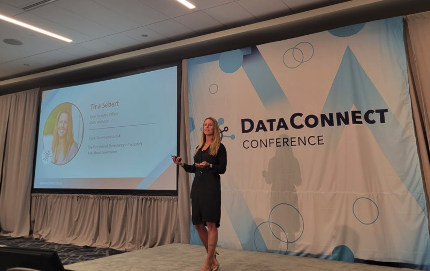
The First Rule of Data Governance is: Don’t Talk About Data Governance

The first rule of data governance is: don’t talk about data governance. But then how do we do it?
Let me start with my “A-ha” moment.
About 10 years ago, the organization I was part of was going through a restructuring and I was asked to lead the customer data governance team. A few weeks later, a colleague inquired about our customer numbers for a new product. With the data stewards, engineers, and master data, I believed the answer would be simple to provide. Much to my dismay, I was wrong.
After running some queries, we ended up with three very different answers to this simple question. The data surely couldn’t be wrong, I thought, but how could we not know how many customers we had?
A meeting ensued. The customer data governance team (who had yet to be engaged) our data engineers, a company expert, and myself all plead our cases for the numbers we came up with.
Then, the lightbulb started to flicker.
I realized we had no consistent definition of what a customer was. Our data may have been accurate based on our own definitions of what a customer was, but because we hadn’t agreed upon the qualifications for a customer, our numbers didn’t match up.
That was the moment I became excited about data governance.
Re-imagining data governance
According to The Data Governance Institute, data governance is a system of decision rights and accountabilities for information-related processes, executed according to agreed-upon models which describe who can take what actions with what information, and when, under what circumstances, using what methods.
Data governance helps us to make better decisions, guarantee transparency, and reduce costs while ensuring data is secure and trustworthy. A study conducted by TDWI uncovered that 36% of data leaders view governance as a priority to improving the success of an organization in relation to business intelligence and analytics.
A need exists for exceptional data governance practices. Data governance is a combination of people, processes, and technology. With good practices in place, the value derived from the data will drive the organization and encourage other departments to get excited and onboard with data.
But how do we reimagine data governance and bring value to it across the whole organization?
- Collaboration
- Defining team roles
- Communication
- Learning from the past
The Importance of Collaboration
Within organizations, there’s a bit of a stigma when it comes to data governance. That’s why it’s important to build a collaborative data governance culture. It all begins by having the right people in place and getting early buy-in from the executive team. In doing so, a successful data governance strategy can be implemented and, in many cases, more easily adopted across the organization.
When roles, responsibilities, and the ownership structure are clearly defined, your data governance practices have a higher chance of finding success. It’s critical to measure the progress of your data governance program to make sure the best practices you have in place are effective.
With collaboration comes communication and the impacts and value of your strategy can be clearly communicated throughout the organization.
Defining Team Roles
Amongst organizations, data governance has been put in several different places. Some would say that it’s lived in IT, it’ an IT problem, IT will solve it.
To improve data quality, input and ownership must come from all parts of your organization. Companies are turning to and relying more on data governance councils within their organizations. This team is comprised of professionals who act as the guiding force behind the data governance strategy. For example, data scientists, engineers, the business team and even professionals from the call center, as they have direct contact with customers, would all provide quality insight. Further, data councils help to build trust and relationships within the community.
Communicating about Data Governance
For data governance to be valued within an organization, it’s necessary to get creative when speaking about it. As a data professional, you may be tempted to talk about numbers and KPIs, but to get other departments excited about the value, you need to tell stories with data; talk impacts, customers, products. The focus needs to be on the business value of data.

Tina Sebert presenting this topic at the DataConnect Conference in Columbus, Ohio- Hosted by Women in Analytics
Data is all about trust. Admittedly, we hear about compliance problems and yes, it happens. Customers lose trust in a company, a brand, and that is a reputation challenge. It’s a compliance issue, but we can’t lose focus on the positive impacts of data collection. Talk about the impacts first, get people in the organization excited and then transition into metrics. Trust is earned, not given. We all want to make sure that our data is trusted.
Learn From the Past
What have we learned? Data governance is not an IT problem. How do we embed governance into our initiatives? It’s a culture change that needs to happen and it’s a heavy lift; an effort in which we all need to partake. We need to act differently. If we act differently, what’s going to happen? We’re going to earn the trust of our partners. We’re going to earn the trust of our executives to make more investments in the tools and initiatives that are going to make our jobs easier. We’re going to give the company the advantage that we’re driving towards.
The Second Rule of Data Governance is…Rebranding?
Poor data governance can lead to inaccuracies, confusion, and loss of trust in enterprise data. Good data governance enables more informed teams, better decision making, and improved operational efficiency. To align your organization with the latter, I believe it’s important to rethink the traditional approach to data governance by changing the way we collaborate, communicate, and learn from the past. Putting these three tactics into action can drastically improve the culture of data governance within your organization.
However, some believe that data governance is played out and there’s no chance of whipping the negative stigma. To them I say, “What about a rebrand? Can we get the culture change that’s needed if we rebrand our governance?”
I challenge you to explore this idea and share your thoughts in the comments.
To explore the idea of rebranding data governance more, check out this video to hear what data professionals at the DataConnect Conference in Columbus, Ohio- Hosted by Women in Analytics had to say.
At Apexon, we offer end-to-end Data Governance services to help you achieve your data governance goals. We help market leaders and emerging startups achieve faster insights, better data understanding, improved decision-making, increased collaboration, and regulatory data compliance. To learn more, check out Apexon’s Data Governance Services.